| Description | Participants | Summaries | Products |
|---|
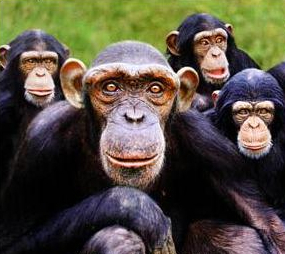
Archived NIMBioS Working Group
Hierarchy and Leadership
Topic: Emergence of Hierarchy and Leadership in Mammalian Societies
Meeting dates: April 25-27, 2013; November 18-20, 2013; April 21-23, 2014; October 13-15, 2014
Organizers:
Eric Alden Smith, Anthropology, Univ. of Washington
Claire El Mouden, Zoology, Univ. of Oxford
Sergey Gavrilets, Ecology & Evolutionary Biology and Mathematics, Univ. of Tennessee
Objectives. The goal of the working group is to analyze factors favoring the emergence of leadership and hierarchies (and resultant inequality in power, resources, and reproductive outcomes) across a range of animal species and humans. The animal species selected (primates, hyenas, etc.) are ones with sufficient cognitive complexity to support facultative variation in social organization, making them more directly comparable to humans. Similarly, the human cases will be restricted to small-scale societies of foragers, pastoralists, and horticulturalists, which lack the elaborate and formal institutions of complex societies. The evolution of social organization is of long-standing interest in both biology and the social sciences (especially anthropology). Of particular interest to the working group is the transition from systems where differences in power are based on individual characteristics or kin-based alliances to ones with hierarchical structures and clear leadership roles that extend beyond dyadic dominance relations and kinship ties. These systems vary in the form and degree of hierarchy (dominance/subordination), in the mechanisms limiting conflict and enhancing cooperation between group members (e.g., reward vs. punishment), and in the importance of factors such as leadership, coalitions, and individual differences ("personalities"). We will draw upon theoretical work in both the biological and social sciences. Our working group effort will involve a combination of advanced modeling efforts (based on game-theoretic, population genetics, behavioral ecology, and agent-based models) and empirical synthesis. The aim of the working group is to produce a series of high-impact collaborative research papers that would be of interest to researchers in multiple disciplines. Beyond publications, it is anticipated that collaborations between various participants will extend well into the future.
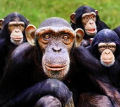
Meeting Summaries
| Mtg # | Dates | Agenda | Summary | Photo | Evaluation |
|---|---|---|---|---|---|
| 1 | Apr 25-27, 2013 | Link | Link | Report | |
| 2 | Nov 18-20, 2013 | Link | Link | ||
| 3 | Apr 21-23, 2014 | Link | Link | ||
| 4 | Oct 13-15, 2014 | Link | Link |
Meeting 1 Summary. The meeting started with introductory half-hour talks by all group members, which took a day and a half. During the general discussion on the second day, the group identified a number of different topics of mutual interest including 1) relationship between dominance and leadership, 2) effects of personality, kin, and coalitions on leadership, 3) relationship between coordination and collective action problems in leadership, 4) possible evolutionary paths from consensus-making to formalized leadership, 5) relationships between leadership by example and leadership by coercion, and 6) patterns in reproductive skew and its determinants. The group discussed various experimental and theoretical approaches to studying the emergence of leadership as well as possible comparative analyses across a number on non-human animals and humans. The group has established several sub-groups, which are to report their progress at the next group meeting in the fall.
Meeting 2 Summary. The meeting began with an introductory talk from Daniel Nettle, who described two strands of his research relating to hierarchy, one on contemporary British populations differing by socioeconomic class, longevity, health, and risk of violent death, and the other on experiments investigating the physiological effects of differential status in starlings. This was followed by reports from two subgroups (on leadership in mammalian groups, and on reproductive skew in humans), plus some individual presentations (on correlates of leadership in the Sukuma, on dynamics of consensus building, on two public goods experiments, and on between-group conflict and within-group inequality). The group discussed the progress on and challenges of writing a review paper about leadership as well as performing a cross-cultural experimental economics study of leadership. Two subgroups focused on the nature of existing data on reproductive skew and on developing appropriate procedures for performing a meta-analysis of such data. A new subgroup to examine the emergence and dynamics of hierarchy in small-scale human societies was formed, and presented their initial ideas to the full working group. The working group plans to have its next meeting in the spring of 2014.
Meeting 3 Summary. The meeting started with reports from two subgroups (on leadership in mammalian groups and on reproductive skew in humans), plus some individual presentations from group members. We agreed to turn the reproductive skew project into two separate papers. The first paper will compare reproductive skew in humans to other mammalian species. The second paper will focus on reproductive skew in small-scale societies. Preliminary data from the literature review of reproductive skew was presented, and the Working Group agreed that we would expand the number of mammals being included in the review. The Working Group is developing a new measure for reproductive skew, termed the 'C-index', which addresses an issue that present measures have regarding comparability across different sample sizes. We will use this new measure to assess reproductive skew in human small-scale and mammalian societies. The second project is a review paper on leadership in human and mammalian societies. The group agreed on a glossary of terms that can be applied to human and non-human leadership. The group also developed a multi-axis scale to characterize different forms and dimensions of leadership. Preliminary data was also examined, and the group agreed to collect representative leadership data to illustrate the different dimensions of leadership. The working group plans to have its final meeting in October 2014.
Meeting 4 Summary.
The group made significant progress toward completing its work. The group's effort was mostly devoted to two review papers: the first, "Leadership in mammalian and small-scale human societies," is a review that offers a transdisciplinary synthesis of biological and social-science views of leadership from an evolutionary perspective by providing a cross-disciplinary review of the theoretical literature and by summarizing patterns of leadership in a sample of both human and non-human populations (eight human and eight non-human populations). The second paper reviews the data on reproductive skew in human small-scale and mammalian societies. Our group has developed a new measure for reproductive skew, termed the 'M-index', which allows comparison of data from different populations without introducing sample size bias. Several group members have given short research presentations on related topics. The group will collaborate remotely while finishing up.
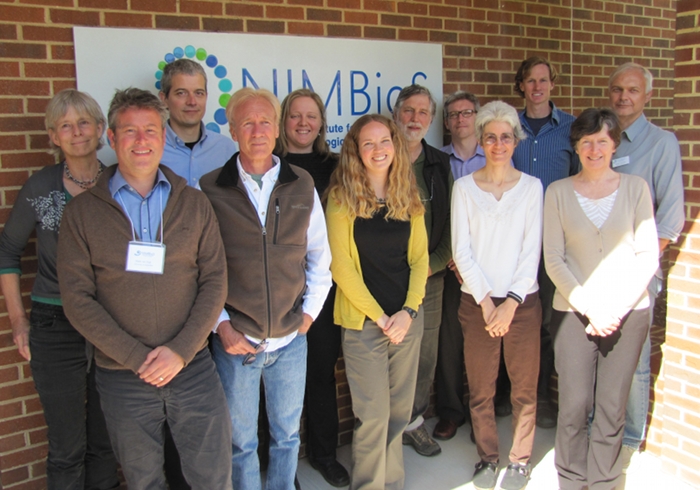 |
| Meeting 1. (Back row, L to R): Monique Borgerhoff Mulder, Christoph Hauert, Claire El Mouden, Eric Alden Smith, Geoff Wild, Paul Hooper, Sergey Gavrilets. (Front row, L to R): Mark van Vugt, Kim Hill, Jennifer Smith, Susan Perry, Anne Pusey |
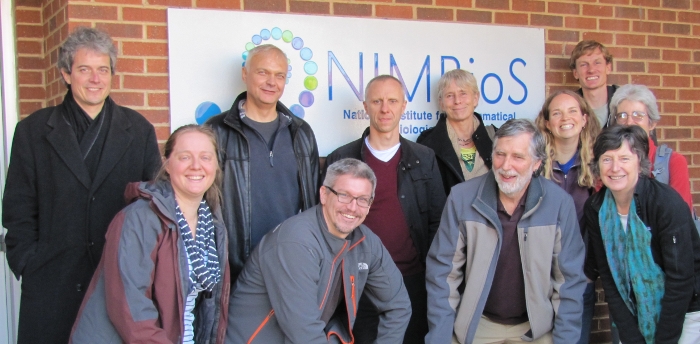 |
| Meeting 2. (Back row, L to R): Christoph Hauert, Sergey Gavrilets, Daniel Nettle, Monique Borgerhoff Mulder, Jennifer Smith, Paul Hooper, Susan Perry. (Front row, L to R): Claire El Mouden, Geoff Wild, Eric Alden Smith, Anne Pusey |
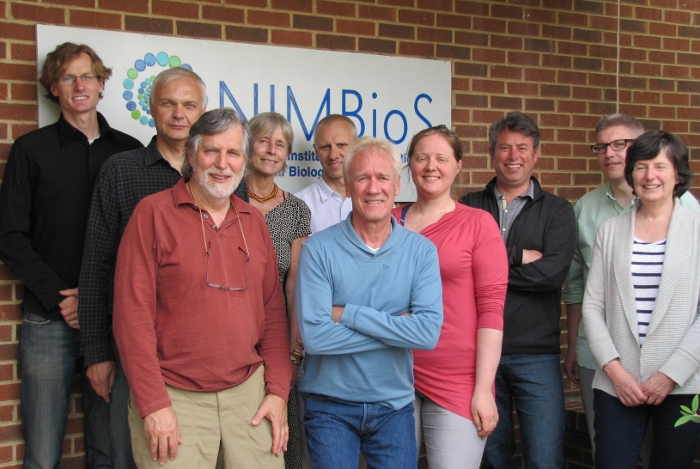 |
| Meeting 3: (Back, L to R) Paul Hooper, Sergey Gavrilets, Monique Borgerhoff, Daniel Nettle, Mark van Vugt, Geoff Wild; (Front, L to R) Eric Alden Smith, Kim Hill, Claire El Mouden, Anne Pusey. |
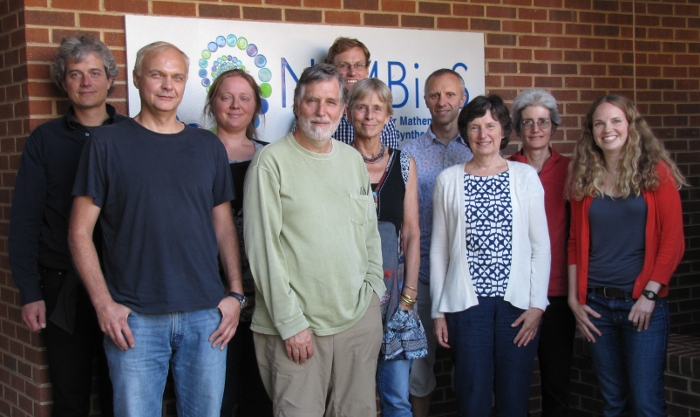 |
| Meeting 4: (L to R) Christoph Hauert, Sergey Gavrilets, Claire El Mouden, Eric Alden Smith, Paul Hooper, Monique Borgerhoff, Daniel Nettle, Anne Pusey, Susan Perry, Jennifer Smith |
NIMBioS Working Groups are chosen to focus on major scientific questions at the interface between biology and mathematics. NIMBioS is particularly interested in questions that integrate diverse fields, require synthesis at multiple scales, and/or make use of or require development of new mathematical/computational approaches. NIMBioS Working Groups are relatively small (up to 10 participants), focus on a well-defined topic, and have well-defined goals and metrics of success. Working Groups will meet up to 3 times over a two-year period, with each meeting lasting up to 2.5 days.
A goal of NIMBioS is to enhance the cadre of researchers capable of interdisciplinary efforts across mathematics and biology. As part of this goal, NIMBioS is committed to promoting diversity in all its activities. Diversity is considered in all its aspects, social and scientific, including gender, ethnicity, scientific field, career stage, geography and type of home institution. Questions regarding diversity issues should be directed to diversity@nimbios.org. You can read more about our Diversity Plan on our NIMBioS Policies web page. The NIMBioS building is fully handicapped accessible.
NIMBioS
1122 Volunteer Blvd., Suite 106
University of Tennessee
Knoxville,
TN 37996-3410
PH: (865) 974-9334
FAX: (865) 974-9461
Contact NIMBioS


